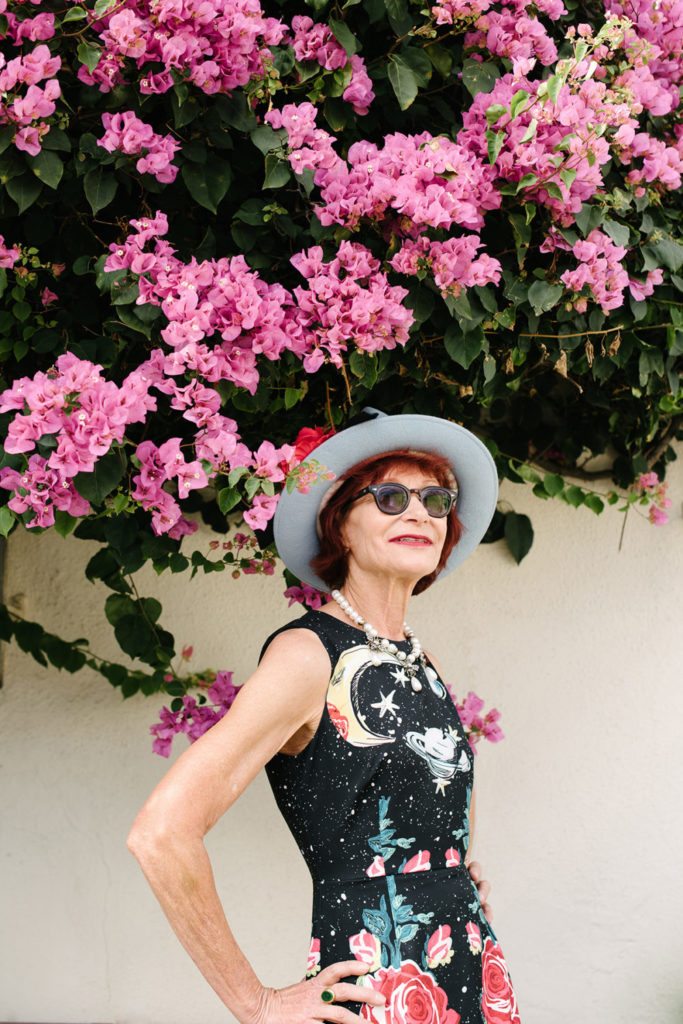 Nancy Hunt rarely slows down. With bright red hair, a toothy grin and an imaginative style-pushing wardrobe, Hunt can be spotted all over town attending the snappiest art shows, the coolest concerts and most regularly, overseeing Brat, her eclectic Santa Monica clothing and gift boutique.
Nancy Hunt rarely slows down. With bright red hair, a toothy grin and an imaginative style-pushing wardrobe, Hunt can be spotted all over town attending the snappiest art shows, the coolest concerts and most regularly, overseeing Brat, her eclectic Santa Monica clothing and gift boutique.
But Brat isn’t her first ride at the retail rodeo. Hunt’s history as a fashion innovator in the early days of Los Angeles punk rock began with the 1976 opening of her store Na Na in Santa Monica. Before MTV and Hot Topic, her vision and experimentation in both designing and selling creative punk wardrobe and shoes was crucial to the evolution of 1980s (and beyond) style — and set many trends which ultimately spread like a wildfire across America, defining style for a generation.
The store’s name, Na Na, came from Nancy’s own nickname, borrowed from a flamboyantly dressed character in a novel by Émile Zola, who rises from the gutter to the height of Parisian society. From the beginning Na Na carved out its own identity, making clothing items that had not yet been dreamed up.
“Punk rock clothes weren’t manufactured, so we took it upon ourselves to start creating stuff,” Hunt, originally from St. Louis, explains. She’d started by making skirts out of shirts, and sewing patches and upside down pockets on miniskirts, and moved to experimenting with whatever struck her fancy. “At the time military surplus was quite inexpensive,” she says. “In the back of the store, on a loft we’d built, I’d systematically cut sleeves off of jackets, sew on patches and put zippers on everything, embellishing them so they became like vests. They became a very prominent uniform for some of the punks. The store’s rent was incredibly cheap, so it was easy to stay open.”

Nancy Hunt
During a trip to London around that time Hunt was introduced to Doc Marten, a British utility shoe made in black, red and brown, mostly worn by postmen and blue collar workers. She also discovered Monkey Boots, a standard issue Czechoslovakian army boot, and creepers, a shoe with thick crepe soles and suede uppers. Though these types of footwear were already being worn by British punks, none were easily available or even heard of in the United States. Hunt approached English factories about importing the shoes for Na Na. “We brought them in to try them, and soon after they sold so well we approached Doc Marten with doing different colors of leather, “ Hunt remembers. “We branded all of our shoes with the Na Na label and our own sock. All made in the factory in England.”
Doc Martens took off, becoming so popular that Na Na began ordering massive numbers and wholesaling them to other stores throughout the city, the state and eventually the whole country. The Na Na store expanded in size to take up a whole Santa Monica block, creating a specific shoe store and then opening other locations in Los Angeles, San Francisco and New York. They imported motorcycle jackets, Merc suits and multi-colored suede jackets from the U.K., as well as T-shirts, jewelry and punk accessories.
“Kids would travel for hours to Na Na because they could get everything,” says Hunt. “We carried all the bells and whistles. Black skinny jeans had not been made yet, so in the beginning we were getting plain skinny jeans and dying them black. We were helping to define the uniform for that age.”
Hunt’s stores were frequented by the trendsetters of the day, who in turn wore their looks and helped the styles spread, everyone from Madonna, Lou Reed and David Lynch to the Bangles, the Cramps, Kurt Cobain, Tupac and TLC.
Though groundbreaking from the late ’70s to the late ’90s, as times changed Na Na eventually closed its stores, with Hunt’s offshoot Brat store opening in 2001 and continuing to sell unique fashion and gifts. Cool clothes are a lot easier to get these days thanks to the internet, but the legacy Hunt created was revolutionary and its still being seen today. Her creativity continues to radiate too. “I’m always looking for what’s around the next corner,” the style maven states proudly. “I have complete faith in creative young people. They are not going to go away and they will always make themselves heard. I hope even now that I can continue to inspire people. It is more important now than it ever has been.”
Advertising disclosure: We may receive compensation for some of the links in our stories. Thank you for supporting LA Weekly and our advertisers.

